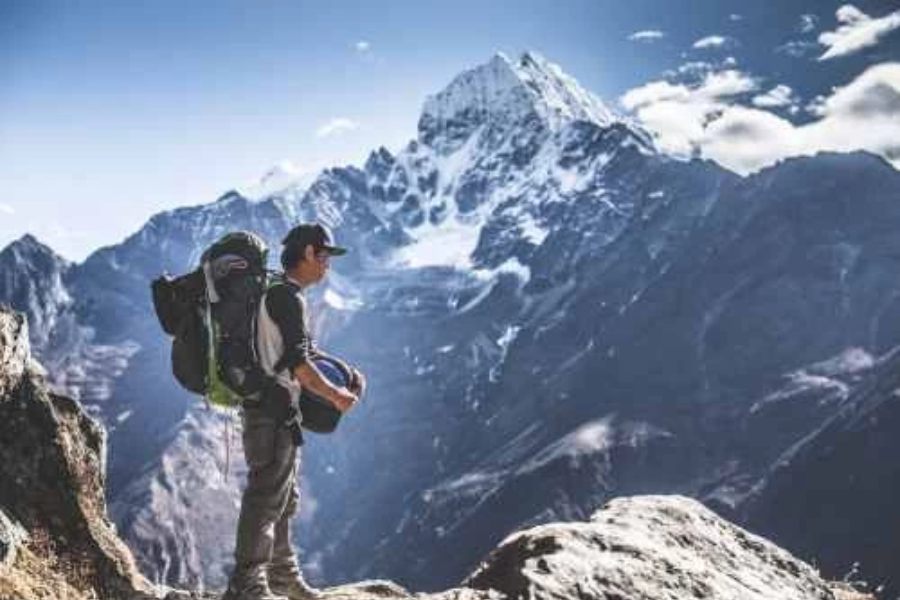Everest Base Camp Trek Tales of Triumph and Adventure
The Everest Base Camp trek is renowned for its breathtaking vistas and the immense sense of achievement that comes with reaching the foothold of the world’s highest peak. However, beyond the spectacular landscapes and rigorous physical challenges, this journey is steeped in tales of triumph and adventure that capture the essence of human resilience and determination.
The trek begins in the vibrant city of Kathmandu, where trekkers from all walks of life converge, each with their own story and dream of conquering the heights of Everest. From here, the journey takes them through the rugged terrain of the Khumbu region, characterized by steep ascents, picturesque villages, and the ever-present sight of the majestic Himalayas. Each step along this path is a testament to the trekkers’ courage and perseverance.
One of the most compelling tales of triumph comes from the experience of a group of trekkers who, despite facing severe weather conditions and physical exhaustion, managed to reach Everest Base Camp. Their journey was marked by moments of extreme cold, high winds, and thin air, yet their unwavering determination and camaraderie kept them going. This group’s story is a powerful reminder of the human spirit’s capacity to overcome adversity and achieve its goals.
Adventures along the trail also weave into the narrative of the trek. Stories of unexpected encounters with local Sherpas, sharing traditional meals in remote teahouses, and witnessing the vibrant culture of the Khumbu region add depth to the trekking experience. These interactions provide a rich tapestry of experiences that transform the physical journey into an immersive cultural adventure.
Another poignant tale is that of trekkers who, despite battling altitude sickness, chose to descend and prioritize their health over their summit aspirations. Their decision underscores the importance of listening to one’s body and making safety a priority. The trek’s challenges and triumphs are not solely defined by reaching Base Camp but by the personal growth and lessons learned along the way.
The trek’s conclusion at Everest Base Camp is often an emotional high point. For many, standing at the base of the world’s highest peak is the culmination of months of preparation and personal sacrifice. The view of Everest towering above, surrounded by the stark beauty of the surrounding peaks, is both humbling and exhilarating. This moment of triumph is celebrated with a sense of accomplishment that resonates deeply with every trekker.
In essence, the Everest Base Camp trek is more than a physical journey; it is a collection of individual and collective stories of triumph, perseverance, and adventure. Each tale adds to the rich narrative of this iconic trek, illustrating the incredible feats that can be achieved against the backdrop of the world’s highest mountains.
Introduction
The Everest Base Camp trek is not merely a challenging journey to the foot of the world’s highest peak; it is a transformative adventure rich with personal stories of triumph and unforgettable encounters. Embarking on this trek is a rite of passage for many, driven by the desire to experience the majesty of the Himalayas and to test their limits. The trek offers a unique blend of physical endurance and emotional fulfillment, weaving together stories of perseverance, camaraderie, and cultural discovery. As trekkers traverse the rugged terrain and high-altitude paths, they encounter moments of triumph, struggle, and deep personal reflection. This journey is not just about reaching a destination but about the experiences and stories gathered along the way, making it a profound and rewarding adventure.
Historical Overview
The Everest Base Camp trek, with its rich historical significance, is a tribute to the heroic expeditions that paved the way to Everest. The trek’s origins are closely linked to the early explorations of the Himalayas, particularly the legendary expeditions of Sir Edmund Hillary and Tenzing Norgay in 1953, who were the first to reach the summit of Mount Everest. The base camp itself has served as the starting point for numerous pioneering climbs and continues to be a symbol of human endurance and exploration. Historically, the trek has evolved from a challenging expedition into a more accessible journey for adventure enthusiasts from around the globe. It has become a pilgrimage for those inspired by the stories of early explorers and the ongoing allure of Everest’s formidable heights.
Personal Triumphs
Personal triumphs during the Everest Base Camp trek are as varied as the trekkers themselves. For many, the trek represents a monumental achievement, overcoming physical challenges and pushing personal boundaries. Stories abound of individuals who, despite facing harsh weather, altitude sickness, and physical exhaustion, reach Base Camp through sheer determination and grit. Each trekker’s story is a testament to their resilience and strength, reflecting personal goals achieved and obstacles overcome. Triumphs are celebrated not just in reaching the base camp but also in the journey itself—whether it’s successfully adapting to the altitude, forming lasting friendships, or conquering a particularly tough stretch of trail. These personal victories are often shared with fellow trekkers and guides, creating a sense of collective achievement and camaraderie.
Memorable Encounters
Memorable encounters are integral to the Everest Base Camp trek Itinerary, enriching the experience beyond the physical challenge. Trekkers frequently meet local Sherpas, whose knowledge, hospitality, and stories add depth to the journey. These encounters often include sharing traditional meals in teahouses, exchanging stories of their respective journeys, and learning about the Sherpas’ profound connection to the mountains. Interactions with fellow trekkers from around the world also create lasting memories, as shared experiences forge strong bonds and friendships. The beauty of these encounters lies in the mutual respect and understanding developed amidst the rugged terrain, turning a challenging trek into a journey filled with shared human experiences and cultural exchange.
Cultural Experiences
The Everest Base Camp trek offers rich cultural experiences that deepen the adventure beyond the physical demands. As trekkers make their way through the Khumbu region, they are immersed in the vibrant culture of the Sherpa people, whose traditions and way of life are deeply intertwined with the mountains. Visitors encounter Buddhist monasteries, such as the Tengboche Monastery, where they can witness spiritual rituals and gain insights into local religious practices. Traditional festivals, local craftsmanship, and the warm hospitality of the Sherpa communities provide a deeper understanding of the cultural tapestry that defines the region. These cultural interactions not only enhance the trekking experience but also foster a greater appreciation for the rich heritage and traditions that thrive in the shadow of Everest.
Challenges Faced
The Everest Base Camp trek is renowned for its breathtaking beauty, but it also presents numerous challenges that test trekkers’ physical and mental endurance. One of the primary challenges is the altitude, as the trek reaches heights above 5,000 meters (16,404 feet), where oxygen levels are significantly lower. This can lead to altitude sickness, manifesting as headaches, nausea, and dizziness, and requires careful acclimatization. Trekkers also face unpredictable weather conditions, including cold temperatures, high winds, and snowfall, which can make the trek more demanding. The rugged terrain includes steep ascents and descents, rocky paths, and suspension bridges, which add to the physical strain. Additionally, long trekking days, often spanning several hours, test stamina and resilience. Despite these difficulties, the trek’s challenges are part of what makes reaching Everest Base Camp such a profound achievement.
Lessons Learned
The Short Everest Base Camp trek imparts valuable lessons that extend beyond the physical journey. One crucial lesson is the importance of preparation and adaptability. Trekkers learn to respect the unpredictability of high-altitude environments and the need for flexibility in their plans. The trek also teaches perseverance and the significance of maintaining a positive mindset in the face of adversity. Another key lesson is the value of teamwork and camaraderie, as shared challenges foster strong bonds among trekkers and between trekkers and guides. Managing personal limits, understanding the signs of altitude sickness, and the necessity of proper acclimatization are also important takeaways. These lessons are not only pivotal for the trek but also translate into broader life experiences, highlighting resilience, patience, and the ability to overcome obstacles.
Inspiring Stories
The Everest Base Camp trek is filled with inspiring stories of individuals who have triumphed over personal and physical challenges. One such story is that of a trekked who, despite facing significant health issues prior to the journey, trained rigorously and achieved their dream of reaching Base Camp. Another compelling story involves a group of friends who, motivated by a shared goal, supported each other through the trek’s most grueling sections, turning their collective struggle into a powerful testament to friendship and mutual encouragement. Stories of trekkers who have overcome fear of heights or those who have dedicated their trek to honoring loved ones further illustrate the personal and emotional dimensions of the journey. These narratives reflect the courage, determination, and spirit that define the Everest Base Camp experience, inspiring others to embark on their own adventures.
The Role of Guides and Porters
Guides and porters play a crucial role in the success and safety of the Everest Base Camp trek, providing essential support and expertise. Guides, often local Sherpas with extensive knowledge of the terrain and high-altitude conditions, offer navigational assistance, safety guidance, and valuable cultural insights. They help trekkers understand the challenges of the trek and ensure adherence to safety protocols, such as acclimatization schedules. Porters, on the other hand, carry essential gear and supplies, alleviating some of the physical burdens on trekkers. Their hard work and dedication are vital for the smooth operation of the trek, allowing trekkers to focus on the journey itself. The support provided by guides and porters is not only instrumental in achieving the trek’s goals but also enhances the overall experience by offering local perspectives and fostering a collaborative trekking environment.
Celebrating Accomplishments
Reaching Everest Base Camp is a momentous achievement and a cause for celebration. For many trekkers, the final approach to Base Camp is filled with a sense of triumph and relief, culminating in the iconic view of Everest towering above. Celebrating this accomplishment often involves a shared moment of reflection and joy with fellow trekkers and guides, acknowledging the collective effort and personal endurance required to complete the trek. The arrival at Base Camp is marked by commemorative photographs, the signing of the guestbook, and often a celebratory meal or toast. These celebrations are not just about the physical achievement but also about recognizing the personal growth, the bonds forged, and the incredible journey undertaken. Reflecting on the challenges faced and the goals accomplished adds a profound sense of fulfillment and closure to the trek, making the experience even more memorable.
Stay informed with the news and updates on Ubg 24!


